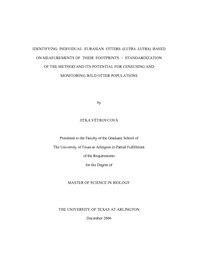| dc.contributor.author | Vetrovcova, Jitka | en_US |
| dc.date.accessioned | 2007-08-23T01:56:04Z | |
| dc.date.available | 2007-08-23T01:56:04Z | |
| dc.date.issued | 2007-08-23T01:56:04Z | |
| dc.date.submitted | December 2006 | en_US |
| dc.identifier.other | DISS-1601 | en_US |
| dc.identifier.uri | http://hdl.handle.net/10106/101 | |
| dc.description.abstract | A method for identifying individual Eurasian otters (Lutra lutra L.) from measurements of their footprints was first tested by performing experiments with captive animals. Digital photographs were taken of imprints in mud of all paws of 12 known individuals. Using customized software, 131 distance, angle, and proportion measurements were generated and subjected to discriminant and canonical analyses. The stepwise procedures of discrimination were the principal statistical analyses used. Analyzing each foot separately while using all available imprints yielded 86-93% correct classification and 59-77% Jacknife cross-validation. The efficiency of these analyses was not significantly affected by randomly reducing the number of imprints per otter. However, better results were achieved when only four best-quality imprints per animal were included in analyses (96-100% correct classification, 70-87% correct Jacknife cross-validation). The method was further improved by combining measurements of both left, both right, or all four feet together in statistical analyses, and was standardized by employing only the best discriminating parameters, identified as such in the previous "preliminary" analyses. The combined analyses all yielded 100% correct classification and 79-93% accuracy of Jacknife cross-validation.
In addition, a short field study was done in order to assess the method's potential for practical application. Four out of seven documented tracks could be analyzed statistically. Both analyses of each foot separately and of left front and left hind feet combined indicated with high certainty that the 4 tracks were made by 4 different otters (100% correct classification and 93-100% efficiency by Jacknife cross-validation). These promising results suggest that the proposed method might prove useful in otter population monitoring and censusing in the future, providing the advantage of being non-invasive and relatively inexpensive. | en_US |
| dc.description.sponsorship | Formanowicz, Daniel | en_US |
| dc.language.iso | EN | en_US |
| dc.publisher | Biology | en_US |
| dc.title | Identifying Individual Eurasian Otters (Lutra lutra) Based On Measurements Of Their Footprints Standardization Of The Method And Its Potential For Censusing And Monitoring Wild Otter Populations | en_US |
| dc.type | M.S. | en_US |
| dc.contributor.committeeChair | Formanowicz, Daniel | en_US |
| dc.degree.department | Biology | en_US |
| dc.degree.discipline | Biology | en_US |
| dc.degree.grantor | University of Texas at Arlington | en_US |
| dc.degree.level | masters | en_US |
| dc.degree.name | M.S. | en_US |
| dc.identifier.externalLink | https://www.uta.edu/ra/real/editprofile.php?onlyview=1&pid=77 | |
| dc.identifier.externalLinkDescription | Link to Research Profiles | |

